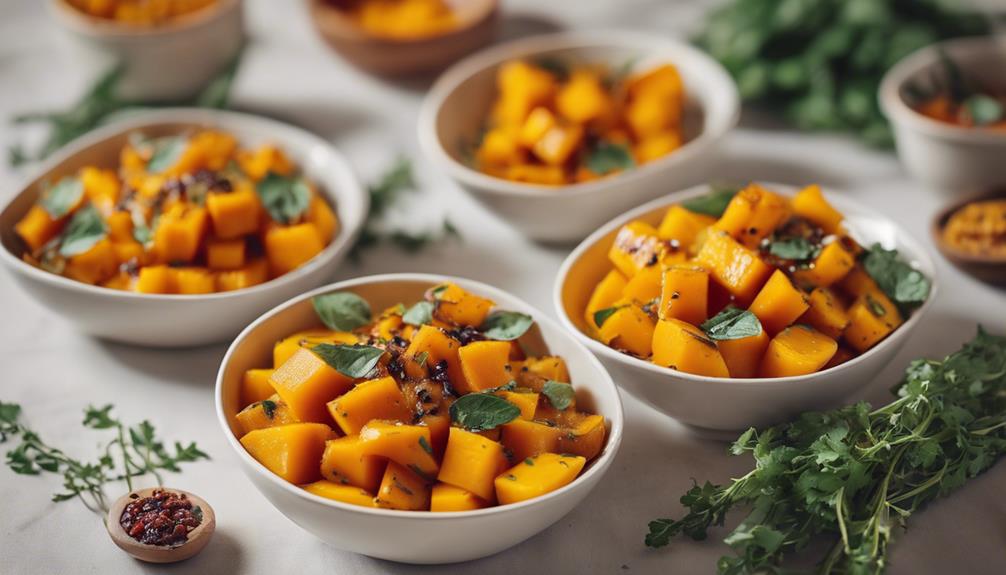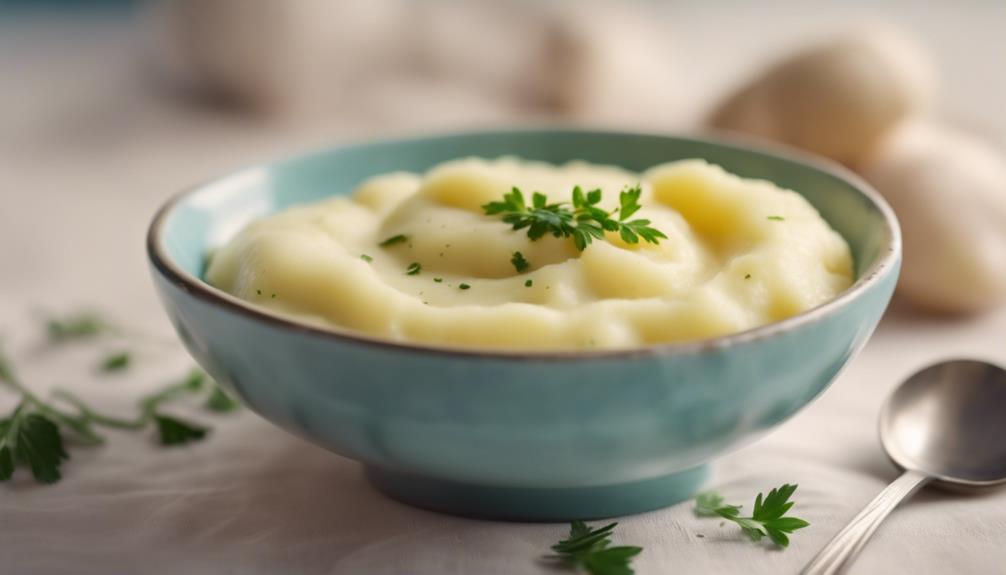For nutritious baby butternut squash recipes, consider roasting to enhance sweetness. Benefits include being rich in vitamins A, C, E, and B vitamins, which are great for brain development and digestion. In terms of safety, make sure to cook until soft and consult your pediatrician for guidance. When selecting squash, opt for firm, ripe ones without blemishes. When roasting, cut uniformly, season to taste, and cook until tender. For baby-led weaning, cut into pieces for self-feeding to promote independence. For freezing, store in containers, label, and thaw before use. These recipes offer a range of nutritious options for your little one’s growth. Discover more detailed healthy baby butternut squash recipes to explore further.
Key Takeaways
- Roasted butternut squash puree: Enhances flavor and texture for baby's palate.
- Butternut squash apple mash: Adds natural sweetness and variety to baby's diet.
- Butternut squash and pear puree: Combines nutrients and gentle flavors for baby's meal.
- Butternut squash and carrot blend: Offers a mix of vitamins and antioxidants for baby's health.
- Butternut squash and oatmeal porridge: Provides a hearty and nutritious meal option for baby.
Benefits of Butternut Squash for Babies
Introducing butternut squash to your baby regularly can greatly enhance their overall health and development. Butternut squash is packed with essential vitamins such as A, C, E, and B vitamins, important for your baby's growth and well-being. These nutrients play a significant role in supporting eye health, skin health, bone health, and brain development in babies.
Moreover, butternut squash is gentle on your baby's stomach and can aid in digestion, particularly when paired with fruits like apples and berries. Its mild flavor and smooth texture make it an excellent choice as a first food for babies starting solid foods.
By incorporating butternut squash into your baby's diet, you can make sure they receive a diverse range of nutrients necessary for their overall health and development.
Safety Considerations for Babies

When introducing butternut squash to babies, always prioritize safety by ensuring the squash is cooked to a soft consistency to prevent choking hazards.
Remember to consult with your pediatrician before incorporating new foods into your baby's diet to monitor for any potential adverse reactions.
Following a gradual food introduction timeline can help identify any allergies or sensitivities early on.
Baby Food Preparation
For safe preparation of baby food, prioritize making sure the butternut squash is thoroughly cooked until soft to aid in easy digestion.
When making butternut squash puree for babies, it's essential to cook the squash until it's tender. This guarantees that it's easily mashable or blendable in a food processor, creating a smooth texture that's safe for your little one to eat.
After preparing the butternut squash puree, remember to store it properly. Place the puree in airtight containers and store them in the fridge for up to four days. Alternatively, you can freeze the puree in cubes for longer preservation, up to four months.
To maintain freshness and avoid confusion, always label the containers with the date and the name of the food.
Food Introduction Timeline
Start by considering your baby's readiness cues, such as good head control and ability to sit with support, when introducing new foods like butternut squash around 6 months of age.
Butternut squash baby food is often recommended as one of the best first foods due to its nutrient content and mild flavor.
When beginning on the food introduction timeline, it's essential to prioritize developmental signs over age. If unsure about when to start, consulting a pediatric handout or healthcare provider can provide guidance tailored to your baby's specific needs.
Begin by offering small amounts of butternut squash to monitor for any adverse reactions or allergies in your baby.
Whether following traditional feeding methods or exploring baby-led weaning, introducing butternut squash can be a nutritious addition to your baby's diet.
Making butternut squash a part of your baby's early food experiences can set the stage for a varied and healthy diet in the future.
Allergy Monitoring Tips
Make sure you carefully monitor your baby for any signs of allergic reactions when introducing butternut squash into their diet. Allergies to butternut squash are rare but can still happen, so it's important to be vigilant. Look out for symptoms like rash, hives, vomiting, or difficulty breathing after feeding your baby butternut squash.
If you have concerns about potential allergies, consult your pediatrician, especially if there's a family history of food allergies. Keeping a food diary can help track your baby's responses to new foods, including butternut squash, and pinpoint any patterns or triggers.
Selecting the Best Squash
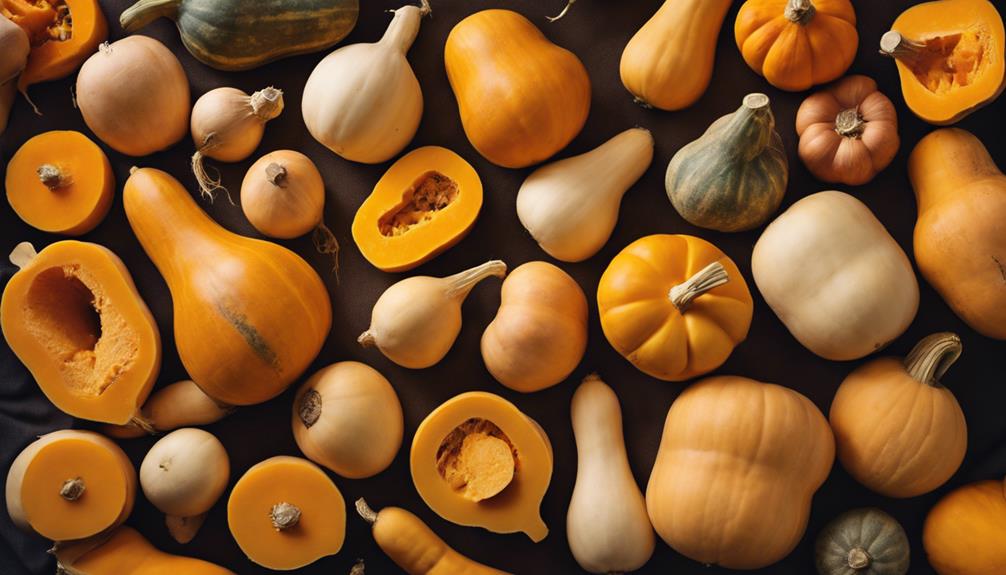
When selecting the best butternut squash for your baby's recipes, remember to choose squash that's dark beige, firm, and without green streaks.
Make sure the squash has an intact stem, no cuts, and is free from soft spots to guarantee the best quality.
Freshness is essential for the best flavor and nutrients, so pick squash with a smooth texture and no blemishes.
Choosing Ripe Butternut Squash
To guarantee you're selecting the best butternut squash for your baby food recipes, look for squash that's firm, solid, and heavy for its size. Choosing ripe butternut squash with a firm texture is important for ensuring high-quality results in your dishes.
Opt for squash that displays a dark beige color without any green streaks on the skin. Make sure the stem is intact, as this indicates freshness and quality. Avoid squash with cuts or soft spots, as these may indicate spoilage.
When you press the squash gently, it shouldn't give in easily or feel mushy; this indicates a good, ripe squash. Remember, selecting a high-quality squash is essential to achieving the best flavor and texture in your baby food recipes.
Inspecting for Freshness
Inspecting for Freshness when selecting butternut squash for your baby's meals is important to ensuring ideal taste and nutrition. To guarantee you're picking the best squash, look for those that are firm, heavy for their size, and free of blemishes.
Opt for a squash with a solid beige color and an intact stem, steering clear of any green streaks or discoloration. When you give the squash a gentle press, it should feel dense and have no hollow areas, signaling freshness.
It's vital to avoid any squash with cuts, bruises, or signs of mold, as these can impact the overall quality and taste of the dish you prepare for your little one.
Optimal Size Selection
For selecting the best squash, consider choosing a butternut squash that feels heavy for its size.
When picking out a butternut squash, keep these factors in mind to make sure you get the best one:
- Weight: A heavy squash indicates ripeness and moisture content, making it a good choice for your recipes.
- Color: Look for a solid beige color without any green streaks, soft spots, or cuts on the skin.
- Skin: Opt for a squash with a firm skin and intact stem, as these are signs of freshness and quality.
- Size: Select a squash that isn't too big, as smaller squash tends to have sweeter and more tender flesh, perfect for your dishes.
Roasting Butternut Squash

Enhance the natural sweetness and flavor of butternut squash by roasting it until caramelized. Roasting butternut squash is a simple and hands-off method that brings out its nutty undertones, making it a versatile ingredient for various recipes. This cooking technique not only boosts the taste but also helps to caramelize the squash, adding depth to the dish.
Additionally, roasted butternut squash can be easily pureed, making it a suitable option for baby food. When roasting butternut squash, make sure to cut it into uniform pieces to promote even cooking. Preheat your oven to around 400°F, toss the squash with olive oil, salt, and pepper, then spread it out on a baking sheet in a single layer.
Roast for about 30-40 minutes, turning halfway through, until the squash is tender and caramelized. This method of preparation will result in a delicious and nutritious ingredient for your baby's meals.
Baby-Led Weaning Techniques

Introduce your baby to solid foods through baby-led weaning, a method that encourages self-feeding and exploration of food textures.
When starting your baby on butternut squash or any homemade baby food, consider these techniques:
- Offer appropriately sized finger foods: Cut cooked butternut squash into small, manageable pieces that your baby can easily grasp. This encourages self-feeding and helps develop fine motor skills.
- Allow your baby to explore: Let your little one touch, smell, and taste the butternut squash at their own pace. This hands-on approach promotes a positive relationship with food and encourages a sense of curiosity.
- Emphasize responsive feeding: 'Baby-led weaning allows babies to control their food intake, promoting self-regulation,' says pediatric dietitian Samantha Cassetty. Let your baby decide when they've had enough.
- Aim for variety: Alongside butternut squash, introduce a range of nutritious finger foods to promote a diverse diet. This can help establish healthy eating habits early on.
Storing Cooked Butternut Squash
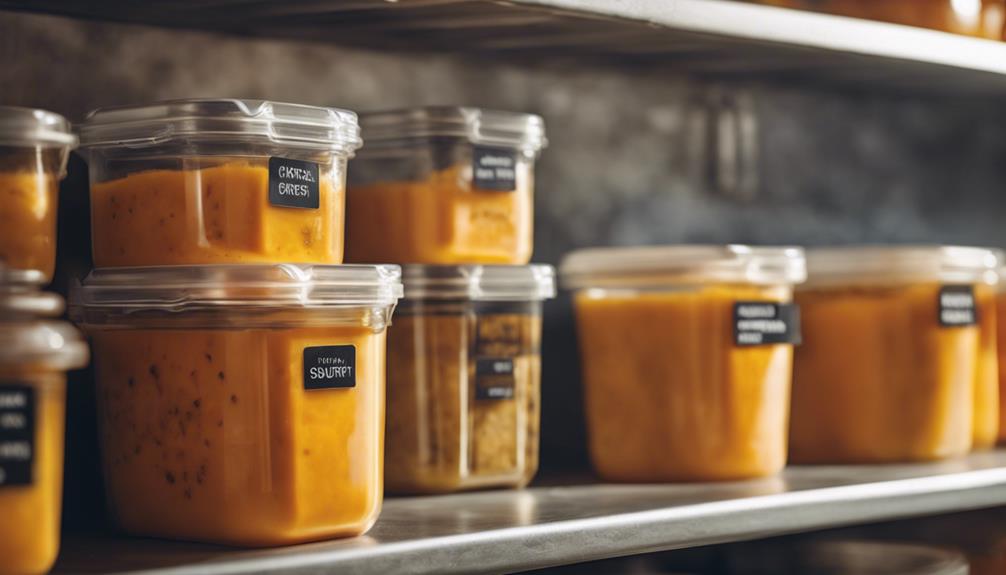
When storing cooked butternut squash, remember to keep it in an airtight container in the refrigerator for up to 4 days.
For longer storage, freeze the squash in a storage container for up to 4 months.
Label the containers with the date for easy tracking of freshness.
Storage Tips
You can store cooked butternut squash in the refrigerator in an airtight container for up to 4 days. To guarantee the best quality and taste, follow these storage tips:
- Freezing Option: For longer storage, freeze cooked butternut squash in a storage container for up to 4 months. This will help maintain its freshness and nutritional value.
- Labeling Containers: Always label containers with the date and name of the contents. This simple step will help you keep track of freshness and avoid confusion.
- Portioning Puree: Freeze butternut squash puree in ice cube trays for easy portioning and thawing. This makes it convenient to serve and control the amount fed to your baby.
- Experimenting with Flavors: Follow your baby's cues for feeding and experiment with different spices and textures when serving stored butternut squash. This can help introduce new flavors and textures to your baby's diet, making mealtimes more enjoyable.
Refrigeration Guidelines
To store cooked butternut squash safely in the refrigerator, place it in an airtight container at or below 40°F within 2 hours of cooking to prevent bacterial growth. It's vital to follow proper food safety guidelines to maintain the quality and freshness of the butternut squash.
By storing it in an airtight container, you create a barrier that helps prevent contamination and keeps the squash moist. Refrigeration inhibits bacterial growth, ensuring your cooked butternut squash remains safe for consumption. Remember to label the container with the date to track its freshness.
Cooked butternut squash can be stored in the refrigerator for up to 4 days. Following these refrigeration guidelines is essential for preserving the flavor and texture of the butternut squash while also safeguarding your health. Always prioritize food safety when storing cooked butternut squash to enjoy it at its best.
Freezing Instructions
Consider freezing cooked butternut squash in airtight containers or freezer bags for long-term storage. This method can keep your homemade baby food fresh for up to 4 months. To make sure you know when it was frozen, remember to label the containers with the date of freezing.
For easy portioning, try freezing the butternut squash in cubes using an ice cube tray. This way, you can conveniently grab the amount you need for your baby's meal without any hassle.
When you want to use the frozen butternut squash, thaw it in the refrigerator before reheating or incorporating it into recipes. By following these steps, you can preserve the flavor, texture, and nutrients of the butternut squash effectively for an extended period.
Proper storage is key to maintaining the quality of your homemade baby food.
Freezing Butternut Squash
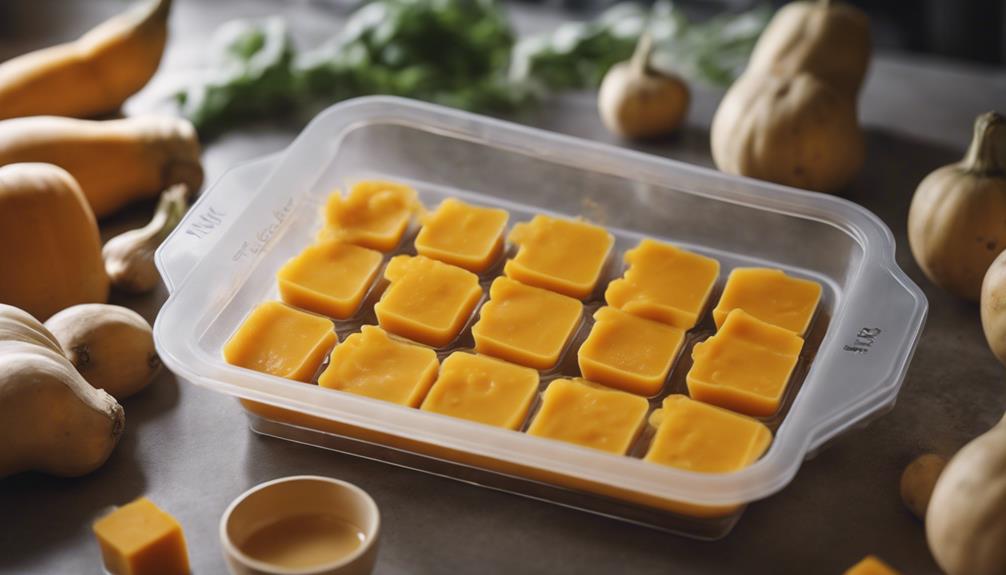
Butternut squash can be preserved by freezing it for up to 4 months in a storage container.
When freezing butternut squash, it's advisable to freeze it in cubes for convenient portioning later on.
Label the storage containers with the date and name to easily identify them in the freezer.
To maintain food safety, it's important to thaw the frozen butternut squash in the refrigerator before reheating or using it in recipes.
Following proper thawing procedures helps prevent spoilage and maintains the quality of the squash when you're ready to enjoy it.
By adhering to these guidelines, you can safely freeze butternut squash and have it readily available for various culinary creations.
Butternut Squash Baby Food Recipes
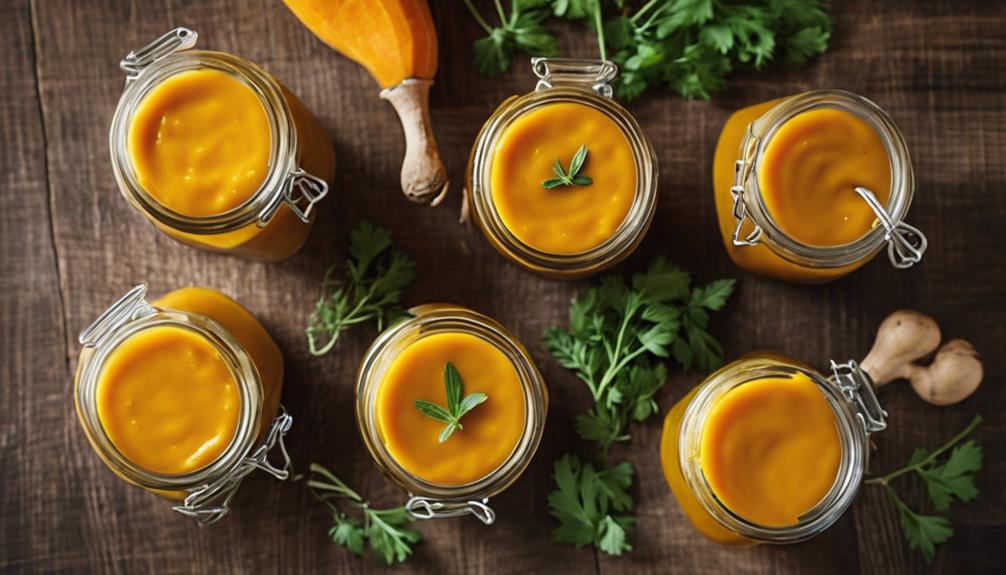
Preserving the nutritional benefits of butternut squash, especially for your little one, can be achieved through preparing wholesome and flavorful butternut squash baby food recipes. By incorporating butternut squash into your baby's diet, you provide essential vitamins A and C, contributing to their growth, immunity, and digestion.
Here are some tips for making nutritious butternut squash baby food:
- Create a smooth butternut squash puree by steaming or roasting the squash until tender, then blending it with a bit of water or breast milk for a creamy texture.
- Experiment with homemade baby food combinations by mixing butternut squash with apples, pears, or carrots to introduce diverse flavors.
- Consider baby-led weaning by offering small, soft butternut squash pieces for your little one to explore and self-feed.
- Utilize freezer storage to batch cook and freeze portions of butternut squash baby food for convenient and quick meals.
Cooking Methods for Babies

To guarantee ideal nutrient retention and flavor development when preparing butternut squash for your baby, consider various cooking methods that cater to their delicate palate and nutritional needs.
Steaming butternut squash is a great option as it helps retain nutrients and natural flavors, ensuring your baby gets the best of this nutritious vegetable.
Roasting butternut squash can enhance its sweetness and create a caramelized texture, adding depth to your baby's meal.
Boiling butternut squash is a simple method that softens the squash for easy pureeing, making it a convenient choice for busy parents.
While microwaving butternut squash is quick, be cautious as it may result in uneven cooking.
Slow cooking butternut squash can develop rich flavors and tenderize the squash for baby food, providing a different culinary experience.
Experiment with these cooking methods to find the one that suits your baby's taste preferences and your schedule best.
Nutritional Notes for Parents
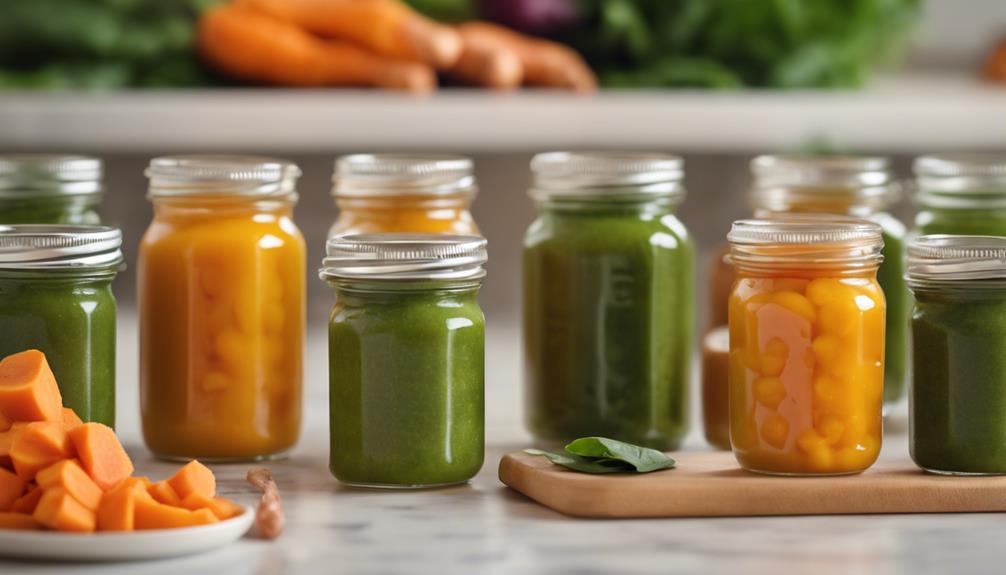
For ideal understanding of your baby's nutritional needs, consider the following essential notes as a parent:
- Vitamins A and C for Growth: Butternut squash is rich in vitamins A and C, essential for your baby's growth and immune system.
- Fiber for Gut Health: The fiber in butternut squash aids in digestion, promoting overall gut health in babies.
- Minerals for Development: Butternut squash provides important minerals like potassium and magnesium, vital for your baby's development.
- Carotenoids for Eye Health: The carotenoids in butternut squash can support eye health and bone strength in infants.
Including butternut squash in your baby's diet may also help enhance iron absorption, important for healthy blood development.
By introducing this nutritious vegetable into your baby's meals, you aren't only providing essential vitamins and minerals but also supporting their gut health, eye health, and iron absorption.
It's a simple yet effective way to make sure your little one receives the necessary nutrients for optimal growth and development.
Frequently Asked Questions
Is Butternut Squash Healthy for Babies?
Yes, butternut squash is healthy for babies. It's packed with essential vitamins and minerals that support growth and immunity. Incorporate it into baby food recipes for a nutritious start to solids. Homemade options give you control over ingredients.
How Do You Serve Baby Butternut Squash?
To serve baby butternut squash, you can puree, mash, or offer as a finger food. Combine with fruits, veggies, or grains for variety. Try different herbs and spices for flavor. Roasted cubes make a healthy snack.
Can You Eat Baby Butternut Squash?
Yes, you can eat baby butternut squash! Its tender skin and sweet flavor make it a delightful addition to your meals. Roast it for a caramelized touch, steam it for a quick side, or puree it for a creamy treat.
Can I Give My 4 Month Old Squash?
You should not give your 4-month-old squash. Babies' digestive systems aren't fully ready for solids at this age. Wait until around 6 months to introduce foods like butternut squash. Always consult your healthcare provider first.
Conclusion
To sum up, introducing butternut squash into your baby's diet can provide a wealth of nutritional benefits. According to a study published in the Journal of Nutrition, butternut squash is an excellent source of vitamin A, which plays an important role in supporting healthy vision and immune function in infants.
By incorporating these healthy baby butternut squash recipes into your little one's meals, you can help them thrive and grow strong.

